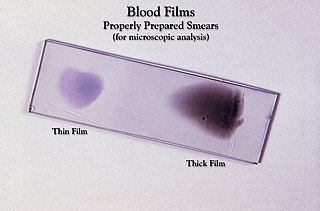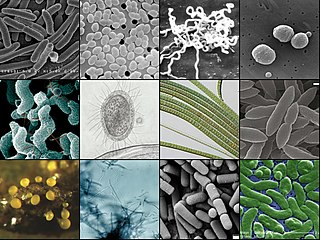
Pathology is the study of disease and injury. The word pathology also refers to the study of disease in general, incorporating a wide range of biology research fields and medical practices. However, when used in the context of modern medical treatment, the term is often used in a narrower fashion to refer to processes and tests that fall within the contemporary medical field of "general pathology", an area that includes a number of distinct but inter-related medical specialties that diagnose disease, mostly through analysis of tissue and human cell samples. Idiomatically, "a pathology" may also refer to the predicted or actual progression of particular diseases, and the affix pathy is sometimes used to indicate a state of disease in cases of both physical ailment and psychological conditions. A physician practicing pathology is called a pathologist.

Fish farming or pisciculture involves commercial breeding of fish, most often for food, in fish tanks or artificial enclosures such as fish ponds. It is a particular type of aquaculture, which is the controlled cultivation and harvesting of aquatic animals such as fish, crustaceans, molluscs and so on, in natural or pseudo-natural environments. A facility that releases juvenile fish into the wild for recreational fishing or to supplement a species' natural numbers is generally referred to as a fish hatchery. Worldwide, the most important fish species produced in fish farming are carp, catfish, salmon and tilapia.

A veterinarian (vet) is a medical professional who practices veterinary medicine. They manage a wide range of health conditions and injuries in non-human animals. Along with this, veterinarians also play a role in animal reproduction, health management, conservation, husbandry and breeding and preventive medicine like nutrition, vaccination and parasitic control as well as biosecurity and zoonotic disease surveillance and prevention.
Veterinary parasitology is a branch of veterinary medicine that deals with the study of morphology, life-cycle, pathogenesis, diagnosis, treatment, and control of eukaryotic invertebrates of the kingdom Animalia and the taxon Protozoa that depend upon other invertebrates and higher vertebrates for their propagation, nutrition, and metabolism without necessarily causing the death of their hosts. Modern parasitology focuses on responses of animal hosts to parasitic invasion. Parasites of domestic animals,, as well as wildlife animals are considered. Data obtained from parasitological research in animals helps in veterinary practice and improves animal breeding. The major goal of veterinary parasitology is to protect animals and improve their health, but because a number of animal parasites are transmitted to humans, veterinary parasitology is also important for public health.
The University of California, Davis, School of Veterinary Medicine is the largest veterinary school in the United States. Established in 1948, the school is the primary health resource for California's various animal populations. In 2020, the school was again ranked No. 1 in the United States by U.S. News & World Report and in 2022, ranked No. 2 in the world by QS World University Rankings. The school is located in the southwest corner of the main campus of the University of California, Davis. The current Dean of Veterinary Medicine is Dr. Mark Stetter.
The Pirbright Institute is a research institute in Surrey, England, dedicated to the study of infectious diseases of farm animals. It forms part of the UK government's Biotechnology and Biological Sciences Research Council (BBSRC). The institute employs scientists, vets, PhD students and operations staff.

Clinical pathology is a medical specialty that is concerned with the diagnosis of disease based on the laboratory analysis of bodily fluids, such as blood, urine, and tissue homogenates or extracts using the tools of chemistry, microbiology, hematology, molecular pathology, and Immunohaematology. This specialty requires a medical residency.
The University of Georgia College of Veterinary Medicine is a college within the University of Georgia (UGA) in Athens, Georgia, United States and is a top 10 ranked veterinary school.
Diphyllobothriasis is the infection caused by tapeworms of the genus Diphyllobothrium.

Veterinary pathologists are veterinarians who specialize in the diagnosis of diseases through the examination of animal tissue and body fluids. Like medical pathology, veterinary pathology is divided into two branches, anatomical pathology and clinical pathology. Other than the diagnosis of disease in food-producing animals, companion animals, zoo animals and wildlife, veterinary pathologists also have an important role in drug discovery and safety as well as scientific research.
Veterinary anesthesia is anesthesia performed on non-human animals by a veterinarian or a Registered Veterinary Technician. Anesthesia is used for a wider range of circumstances in animals than in people, due to animals' inability to cooperate with certain diagnostic or therapeutic procedures. Veterinary anesthesia includes anesthesia of the major species: dogs, cats, horses, cattle, sheep, goats, and pigs, as well as all other animals requiring veterinary care such as birds, pocket pets, and wildlife.

Lernaeocera branchialis, sometimes called cod worm, is a parasite of marine fish, found mainly in the North Atlantic. It is a marine copepod which starts life as a small pelagic crustacean larva. It is among the largest of copepods, ranging in size from 2 to 3 millimetres when it matures as a copepodid larva to more than 40 mm as a sessile adult.
Edwardsiella tarda is a member of the family Hafniaceae. The bacterium is a facultatively anaerobic, small, motile, gram negative, straight rod with flagella. Infection causes Edwardsiella septicemia in channel catfish, eels, and flounder. Edwardsiella tarda is also found in largemouth bass and freshwater species such as rainbow trout. It is a zoonosis and can infect a variety of animals including fish, amphibians, reptiles, and mammals. Edwardsiella tarda has also been the cause of periodic infections for various animals within zoos. E. tarda has a worldwide distribution and can be found in pond water, mud, and the intestine of fish and other marine animals. It is spread by carrier animal feces.
Spring viraemia of carp, also known as swim bladder inflammation, is caused by Carp sprivivirus, also called Rhabdovirus carpio. It is listed as a notifiable disease under the World Organisation for Animal Health.
Veterinary Pathology is a peer-reviewed academic journal that publishes papers in the field of veterinary pathology. As of 2017, the journal's editor is Jeff L. Caswell, Pathology Professor at the University of Guelph. It has been in publication since 1964 and is currently published by SAGE Publications, in association with the American College of Veterinary Pathologists, the European College of Veterinary Pathologists, and the Japanese College of Veterinary Pathologists.

A bacteriologist is a microbiologist, or similarly trained professional, in bacteriology—a subdivision of microbiology that studies bacteria, typically pathogenic ones. Bacteriologists are interested in studying and learning about bacteria, as well as using their skills in clinical settings. This includes investigating properties of bacteria such as morphology, ecology, genetics and biochemistry, phylogenetics, genomics and many other areas related to bacteria like disease diagnostic testing. Alongside human and animal healthcare providers, they may carry out various functions as medical scientists, veterinary scientists, or diagnostic technicians in locations like clinics, blood banks, hospitals, laboratories and animal hospitals. Bacteriologists working in public health or biomedical research help develop vaccines for public use.
The National Veterinary Services Laboratories (NVSL) provides laboratory services for the US Department of Agriculture's Animal and Plant Health Inspection Service (APHIS). It operates from Ames, Iowa and Plum Island Animal Disease Center at Plum Island (New York). The NVSL provides a wide variety of information and services, centered on diagnosis of domestic and foreign animal diseases, support of disease control and eradication programs, reagents for diagnostic testing, training, and laboratory certification.
AniCura AB is a European family of animal hospitals and clinics focused on primary and specialized veterinary care for companion animals. AniCura AB has operations in Sweden, Norway, Denmark, Germany, Austria, Switzerland, the Netherlands, Spain, Italy, France, Belgium, Portugal, Andorra and Russia. The company comprise 450 animal hospitals and clinics that are visited by 3.6 million pets every year, mainly cats and dogs. The total number of employees is approximately 11,000 of whom 4,000 are veterinarians and half have some form of specialist qualification, either national or international specialisation.
Gopal Dhinakar Raj is an Indian veterinary scientist, an academic and the project director of the Translational Research Platform for Veterinary Biologicals, a partnership program between the Department of Biotechnology and the Tamil Nadu Veterinary and Animal Sciences University. Known for the development of diagnostic test kits for animal and poultry diseases such as Leptospirosis and Egg drop syndrome, Raj is a member of the DBT Task Force on Animal Biotechnology. The Department of Biotechnology of the Government of India awarded him the National Bioscience Award for Career Development, one of the highest Indian science awards, for his contributions to biosciences in 2007.
The OIE Aquatic Animal Health Code (AAHC) implements improvement standards of worldwide aquatic animal health and welfare and public health from a scientific point of view. The AAHC "compiles information on diseases of fish, molluscs and crustaceans, and on methods used to control these diseases".






